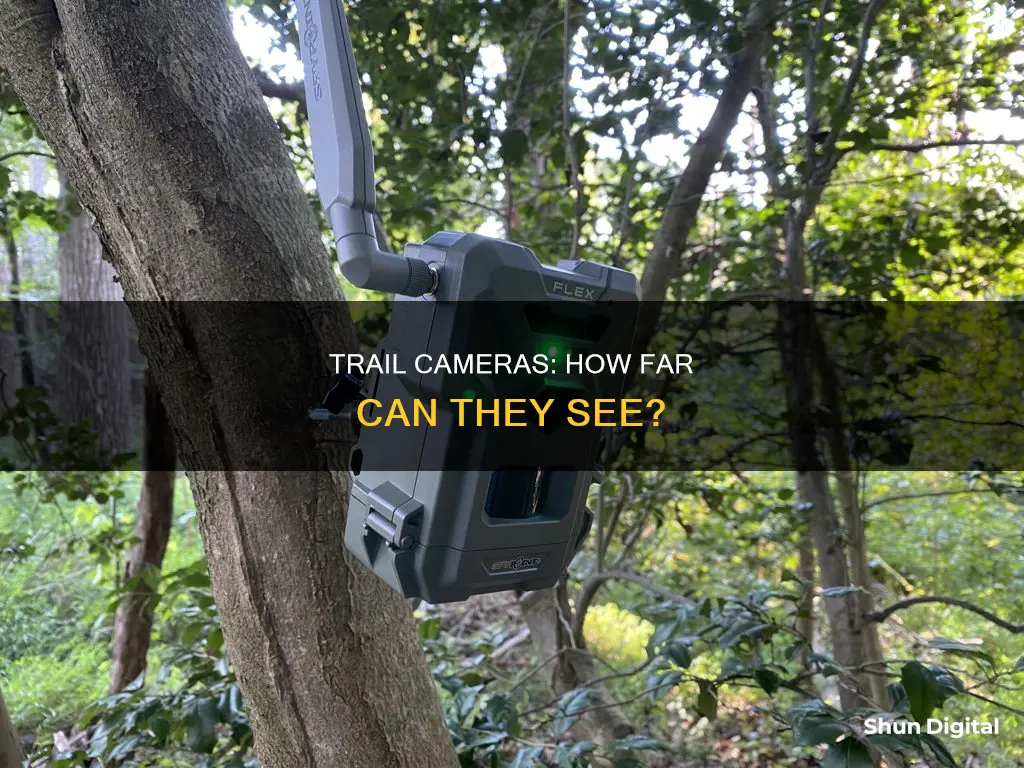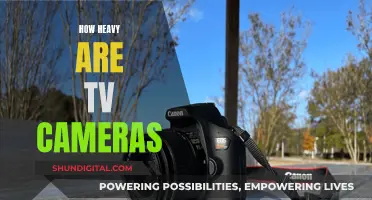
Trail cameras are a great way to capture images of wildlife. They are triggered by a combination of heat and motion, taking photos with little delay. The range of a typical trail camera is about 20 to 130 feet, but this varies across brands and models. For example, the Campark T45A GREEN Trail Camera has a range of up to 65 feet.
The detection distance of a trail camera is the maximum distance it can detect to initiate a trigger, ranging from 40 to 140 feet. The detection angle is the angle at which the camera can detect an animal, and this varies from 32 to 65 degrees. The trigger speed is the time taken to capture a photo once motion is detected, ranging from 0.07 seconds to a full second.
When setting up a trail camera, it is important to consider the location, type of camera, and lens. The camera should be placed at the centre height of the animal's body, directly perpendicular to their line of travel, at a distance of 25 to 35 feet on average.
| Characteristics | Values |
|---|---|
| Typical range | 20 to 130 feet |
| Campark T45A GREEN Trail Camera range | up to 65 feet |
| Flash types | white flash, red or low glow, no glow |
| Detection range | 100 to 120 feet |
| Detection distance | 40 to 140 feet |
| Interpolation | 5 to 20 megapixels |
| Field of view | 32 to 65 degrees |
| Trigger speed | .07 to 1 second |
What You'll Learn

Trail camera detection range
The detection range of a trail camera is the maximum distance at which it can detect movement and trigger a photo. This range can vary from 40 to 120 feet, depending on the make and model of the camera, with some cameras even reaching a detection range of 140 feet. The detection range is an important factor in choosing a trail camera as it determines how much ground the camera can cover and how much information it can collect.
The detection range of a trail camera is influenced by several factors, including the ambient temperature. The difference in body heat between an animal and its surroundings is what triggers the camera, so a greater temperature difference will result in a longer detection range. For example, a camera's detection range could be substantially greater on a cold winter day compared to a hot summer day.
When setting up a trail camera, it is important to consider not only the detection range but also the detection angle and field of view. The detection angle refers to the angle at which the camera can detect movement, and it can be narrower or wider than the field of view, which is the actual angle at which the camera takes a photo. A narrower detection angle may result in the camera missing some movement that is outside of its detection zone, while a wider detection angle may result in the camera triggering before an animal is fully in the frame, leading to empty photos.
To get the most out of a trail camera, it is recommended to place it at the center height of the animal's body, as this gives the camera's passive infrared (PIR) detection system the best opportunity to detect the change in infrared from the surrounding area. The PIR detection system works by detecting the movement of infrared within a linear detection zone across the front of the camera. By hanging the camera at the height of the animal, you increase the surface area for the PIR system to detect, improving the chances of capturing the animal in the photo.
In addition to detection range, there are other important features to consider when choosing a trail camera, such as trigger speed, recovery time, flash type, and picture quality. Trigger speed refers to how quickly the camera reacts to motion, while recovery time is how long it takes for the camera to be ready for a second photo after the first one is captured. White flash cameras take sharp pictures in a wide range of lighting but may scare away game, while no-glow cameras are invisible to humans and most animals but produce lower-quality night photos. Red or low-glow cameras strike a balance between visibility and image quality.
Insignia Smart TV Camera Capability: What You Need to Know
You may want to see also

Trail camera trigger speed
The trigger speed of a trail camera is the amount of time that elapses from when the camera first detects motion to when it captures a picture. The average trigger speed for a trail camera is 0.47 seconds, but this can vary from several seconds to a lightning-fast 1/20th of a second. The best-performing cameras have speeds of 0.5 seconds or less.
A fast trigger speed is important if you want to capture fast-moving animals, such as cheetahs, antelopes, or birds. With a slow trigger speed, you may miss the animal entirely or only capture part of it in the frame. However, a slow trigger speed can be sufficient in some situations, such as when observing deer, which tend to linger in one place for a while.
When choosing a trail camera, it's important to consider not only the trigger speed but also the field of view and detection angle. The field of view is the angle of the photo that the camera takes, typically ranging from 35 to 70 degrees. The detection angle is the angle covered by the camera's Passive Infrared (PIR) sensor, which detects the infrared differential when an animal enters the detection zone, and this usually ranges from 30 to 70 degrees.
To ensure you capture the animal in the frame, you should match the trigger speed to the field of view and detection angle. If your camera has a fast trigger speed, the detection angle should be equal to or smaller than the field of view. This ensures that the camera doesn't take a picture before the animal enters the frame. Conversely, with a slower trigger speed, you may want the detection zone to be larger than the field of view, giving the animal time to move into the frame before the picture is taken.
In addition to trigger speed, recovery time is another important factor to consider. The recovery time is the amount of time required for a camera to rearm itself and take a second picture after capturing the first one. A fast recovery time is crucial when monitoring travel corridors or groups of animals, ensuring that you capture more than just the lead animal.
Remotely Watching Lorex Cameras: A Step-by-Step Guide
You may want to see also

Trail camera recovery time
The recovery time of a trail camera is the amount of time required for the camera to rearm itself and take a second triggered photo after the first photo is captured. This is an important feature to consider when purchasing a trail camera, as faster cameras produce significantly greater amounts of scouting and surveillance data.
When digital trail cameras first became widely available, the technology was adapted from 35mm film cameras, which usually had a maximum of 36 exposures per roll. To avoid a single animal from using up an entire roll of film, engineers limited film cameras to a maximum of one photo per minute. Unfortunately, the first digital trail cameras didn't fully take advantage of their more advanced storage capabilities and adopted the same recovery time. If you're using a camera at a feeding station, recovery time isn't important. However, when covering travel corridors, a camera's recovery time becomes critical.
If you place a slow-recovery camera at a travel corridor, it will only capture the lead animal when a group passes by. This can be frustrating when a camera captures a photo of a doe but misses the enormous buck trailing behind. Therefore, it's important to prioritize recovery time and opt for models with the fastest recovery times possible.
The recovery time of a camera can range from under a second to over a minute. While a low-cost trail camera might be tempting, it's recommended to ensure the recovery time is adequate, especially if you plan on placing the camera on a path or trail.
- Consider the location of your camera. Make sure it's placed in an area where you're likely to see activity—near a stream, in a wooded area, or on a hilltop is ideal.
- Choose the type of camera you're using. A digital trail camera takes photos with little delay, while an infrared trail camera can snap photos even in complete darkness.
- Choose the right lens for your camera. A wide-angle lens captures more of the landscape in front of the camera, while a telephoto lens allows you to zoom in on wildlife in close proximity.
- Get familiar with the settings on your camera before each outing. Changing these settings can impact how well your photos turn out; be sure to read through the manual before each session.
- If desired, add sound to your photos with a motion detector or sound activator option. This will make it easy to identify animal behaviour in your pictures.
Troubleshooting Nightowl Cameras Not Showing on TV
You may want to see also

Trail camera detection angles
There are two types of detection angles: narrow detection angles and wide detection angles. Narrow detection angles, typically 10 degrees or less, were commonly used in the first generation of trail cameras due to their lower cost and ease of design integration. They tend to have a longer detection range as they cover a smaller side-to-side area, but they may result in capturing only part of an animal unless the animal wanders into the centre of the frame.
On the other hand, wide detection angles, usually 40 degrees or more, are more commonly found in newer cameras. They provide a broader detection zone, allowing the camera to capture more information and proving to be more efficient for scouting. However, it is important that the detection angle matches or is slightly smaller than the viewing angle of the photo lens to avoid triggering photos before an animal is fully in the frame, which can result in many empty photos.
When hanging a trail camera, it is recommended to place it perpendicular to the direction in which the animal will be moving. This allows for the most precise detection of infrared changes. Additionally, hanging the camera at the height of the animal's body centre can improve detection as it maximises the surface area within the detection zone. However, this may not always be possible, and in some cases, hanging the camera higher or lower can be advantageous for concealment.
When hanging a camera higher than the height of the animal, it is important to consider the angle and distance. Tilting the camera too steeply to cover the desired area can limit its coverage. In such cases, moving the camera away from the anticipated path of the animal can help maintain a more favourable angle. Hanging cameras close to the ground is another option to keep them out of sight, but this requires careful angle adjustment to avoid capturing only the legs of the animal in the frame.
The Camera's Unique Perspective: Unveiling Its Vision
You may want to see also

Trail camera flash range
The flash range of a trail camera is influenced by a variety of factors, both internal and external. The effectiveness of a trail camera is greatly influenced by its flash range. The flash range of a trail camera is influenced by the type and number of infrared LEDs, energy usage, exposure time, and external factors such as moonlight, cloud cover, and tree canopy.
The type of infrared LEDs used in trail cameras produces light wavelengths ranging from 700 to 940 nanometers, with 850 (red glow) and 940 (no glow) being the most common. Higher nanometer flashes typically produce less illumination and/or use more power, and red glow cameras have been shown to outperform no glow cameras in terms of flash range.
The number of infrared LEDs also impacts flash range. Cameras with a larger number of LEDs will generally have a longer flash range and produce more illumination. However, some cameras with high-intensity LEDs can achieve greater illumination with fewer LEDs.
The amount of energy sent to the flash also affects the flash range. Some cameras prioritize flash strength and range over battery life, resulting in longer flash ranges.
Exposure time is another factor that can be manipulated to extend the flash range. By leaving the shutter open for a longer period, the flash can illuminate objects at a greater distance. However, this often results in blurry photos if there is any movement during the exposure.
External factors such as moonlight, cloud cover, and tree canopy can also impact the flash range. A full moon and clear sky can double the flash range compared to an overcast sky with a crescent moon. A dense tree canopy can reduce the benefits of a full moon or clear sky.
When comparing flash ranges of different trail cameras, it is important to consider the internal and external variables that may impact the results. Factors such as the size and type of monitor, viewing angle, and camera settings can influence the perceived flash distance.
In addition to the flash range, other features to consider when purchasing a trail camera include trigger speed, recovery time, detection range, image quality, and type of flash. Trail cameras with fast trigger speeds and low recovery times are ideal for capturing clear images of moving subjects. The detection range refers to the maximum distance at which the camera can detect motion and take a photo, typically ranging from 100 to 120 feet. White flash cameras offer the widest range of lighting conditions but may scare game, while no-glow cameras are ideal for discreetly capturing black and white images without disturbing animals or humans. Red or low-glow cameras strike a balance between image quality and visibility.
Uniden Camera Viewing: A Step-by-Step Guide
You may want to see also
Frequently asked questions
The range of a typical trail camera is usually about 20 to 130 feet. The Campark T45A GREEN Trail Camera, for example, has a range of up to 65 feet.
The detection distance and interpolation settings of a trail camera determine how far away it should be placed. The detection distance is the maximum distance at which the camera can detect movement, while interpolation duplicates pixels to increase the resolution of the image.
The best height for a trail camera is at the center height of the animal's body, as it gives the camera's PIR detection system the best chance of detecting the change in infrared from the surroundings. However, hanging the camera higher can keep it out of sight, while hanging it lower can result in better photographs at dawn and dusk.
The best angle for a trail camera is perpendicular to the direction in which the animal is moving. This allows the PIR sensor to easily detect changes in infrared.
If hung at the height of an animal's body and perpendicular to their line of travel, the average distance for a trail camera is between 25 and 35 feet. However, each camera has unique specifications for detection distance, field of view, trigger speed, and interpolation, which may alter this distance.







